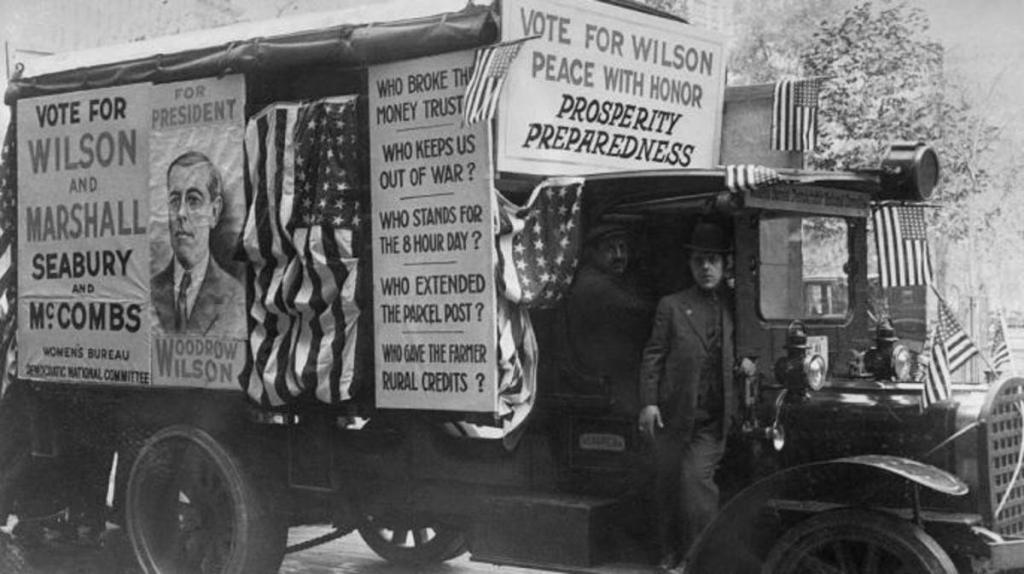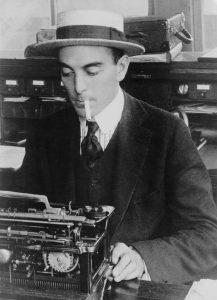In December it is customary to review the major events of the year but I’m far too off-put by this year’s chaos so I decided to take a quick look back at 1916 hoping to find a saner nation and world and to be able to take a happier look at the original ragtime scene.
To begin, I didn’t find a saner time of course. Between the emerging labor crises stemming from an unregulated Industrial Revolution, a contentious Presidential election won by a razor-thin 23 electoral votes, (the winner Wilson’s slogan was “He Kept Us Out of War”!) the economic disruptions of the turn of the century, and of course the accelerating war in Europe. Scientific advances like airships and armored tanks not to mention new projectile germ and chemical agents were taking modern warfare to new levels of horror. America itself in 1916 was nearly as discombobulated as it has been over the past year.
So I turned to the cultural contributions of 1916 to seek relief and found some interesting and positive developments. First, I couldn’t believe that over 125 silent films were produced in 1916. The most, thirty-six, were produced by Hal Roach with his casts always including Harold Lloyd. They were turning out short comedies at the rate of one every eleven days. There were also films by D.W. Griffith, Charlie Chaplin, Roscoe “Fatty” Arbuckle, and Cecil B. DeMille. Casts included the best of the silent era, William S. Hart, Lillian Gish, Douglas Fairbanks, and Lon Chaney. And think of all the background piano and organ players employed to bring the action to life in the era of the great movie palaces like The Circle Theater built in Indianapolis that year.
The publication roster of 1916 is a literary “Who’s Who” of great authors, Mark Twain’s The Mysterious Stranger was issued posthumously, Robert Frost published “The Road Not Taken” and “You Come Too.” There were Jack London and Ring Lardner, Edith Wharton, P.G. Wodehouse and H.G. Wells adding to American libraries. Edgar Rice Burroughs briefly left Tarzan hanging in the jungle to write The Lost Continent and Booth Tarkington gave us Penrod.
In the Sciences Natural and Physical, Einstein published his famous theory of relativity and John Muir wrote The Thousand Mile Walk to the Sea. Margaret Sanger opened her Brooklyn family planning clinic and was immediately arrested for distributing contraceptives.
In Education Maria Montessori and John Dewey gave new direction to American Education and Eugene Debs articulated a new world socialist agenda, Woodrow Wilson wrote On Being Human, and Theodore Roosevelt gave us another book on the strenuous life. There were even classics written in children’s literature by Thornton W. Burgess, and Victor Appleton wrote Tom Swift. Those are just a few of the American authors who had penned away in our reverse centennial year.
As the war in Europe was accelerating toward its worst phase, the U.S. Army invaded Mexico in pursuit of Poncho Villa and the international situation was even more perilous with the Russian Romanovs about to fall to the communists.
Of course, it is in music where I really wanted to relax expecting that one hundred years ago our musical forbears would have provided a veritable visual and auditory massage to sooth our rustled psyches. After all, this is still the Ragtime Era and Jazz was, by then, comfortably matriculating into the cultural mainstream. I was not disappointed.
When I checked in at the U.S. Copyright Office the yearly catalog yielded its bulging index. It seems there were over 150 pieces of music registered with the term “rag” in the title. But then 1916 was nearing the climax of the Ragtime Era and there were many who were, “livin’ a ragtime life” (though that piece was from 1913). Eubie Blake published the “Bugle Call Rag,” and Irving Berlin’s rag says it all, “Everything in America is Ragtime.” Then there was Henry Tressalt who wrote “When They Play Ragtime Tunes at Funerals, That’s the Time I Want to Die.”

Joplin’s 1916 compositions have been lost including his stage piece, If. However 1916 was the year he made six piano rolls on the Connorized Label; two of “Maple Leaf Rag,” “Something Doing,” “Magnetic Rag,” and “Pleasant Moments,” plus W.C. Handy’s “Ol’ Miss Rag.”
Other composers contributed liberally to the ragtime catalog including some classics, There was Artie Mathews’ “Pastime No. 3,” “Rialto Ripples” by George Gerschwin and Will Donadlson, “Top Liner” and “Patricia” by Joseph Lamb, “Honeymoon Rag,” by James Scott and “Blue Goose Rag,” by Charles L. Johnson. W.C. Handy published “Beale Street Blues” in 1916, as well.
“There’s A Long Trail A Winding” (by James F. Harrison) was about to lead to our boys to the trenches in Europe but Harrison also presumptively wrote “Keep the Home Fires Burning ’Til the Boys Come Home” a year before the boys even left. He should have inquired instead with Billy Murray, “Where Did Robinson Crusoe Go With Friday On Saturday Night?” Murray’s recording of Irving Berlin’s “I Love a Piano” also lightened things up a bit.
And on that (blue) note, the Original Dixieland Jass Band was gaining popularity up in Chicago and Wilbur Sweatman was recording his unique “hot” ragtime in New York.
Chu Chin Chow ran for 2238 performances at His Majesty’s Theatre in London and “Pell Mell” at the Ambassador ran for 298. In all 1916 ushered in ten major theatrical openings in New York alone. Charles Ives completed his gargantuan Symphony Number Four requiring two conductors for a performance.
Death took some great people in 1916, including prolific author Henry James, Mildred Hill (“Happy Birthday to You”), artist Thomas Eakins and hoosier poet, James Whitcomb Riley. But, the year saw the birth of musicians Freddie Webster, Bill Harris, Buddy Cole, and Robert Shaw (who conducted first “premiere of Joplin’s “Treemonisha”), Harry James and Dinah Shore. (And FYI, Harriet Janis was eighteen years old and Rudi Blesh was seventeen in the year 1916.)
And so I guess after searching for one hundred year old details instead of recounting this year’s developments, I am generally inclined to say, “the more things have changed, the more they have stayed the same!”
But hark, 2017 approaches with its pristine calendar all bright and clean and hopeful. I’m wishing for a year of more Syncopated Times.
Larry Melton was a founder of the Scott Joplin Ragtime Festival in 1974 and the Sedalia Ragtime Archive in 1976. He was a Sedalia Chamber of Commerce manager before moving on to Union, Missouri where he is currently helping to conserve the Ragtime collection of the Sedalia Heritage Foundation. Write him at lcmelton67@gmail.com.






















